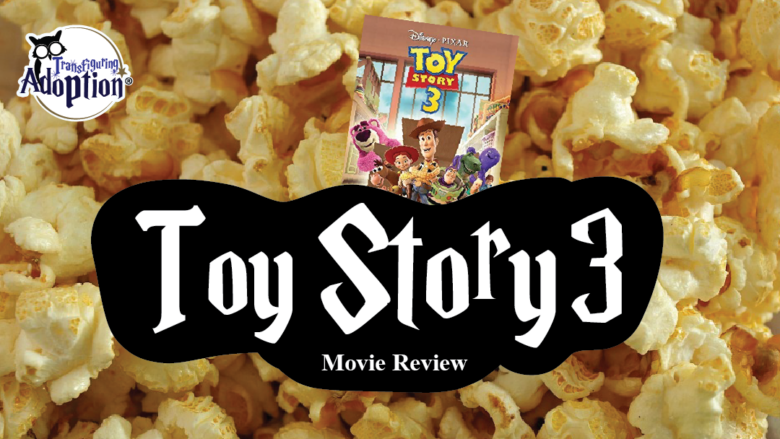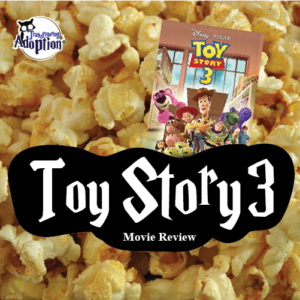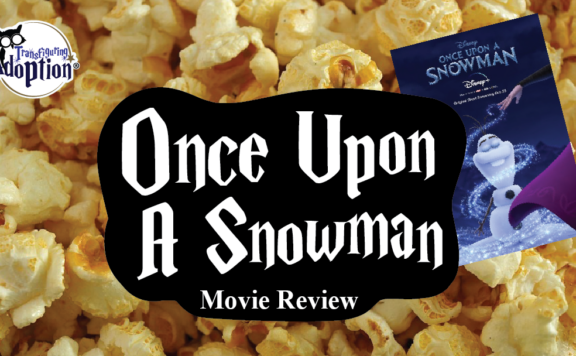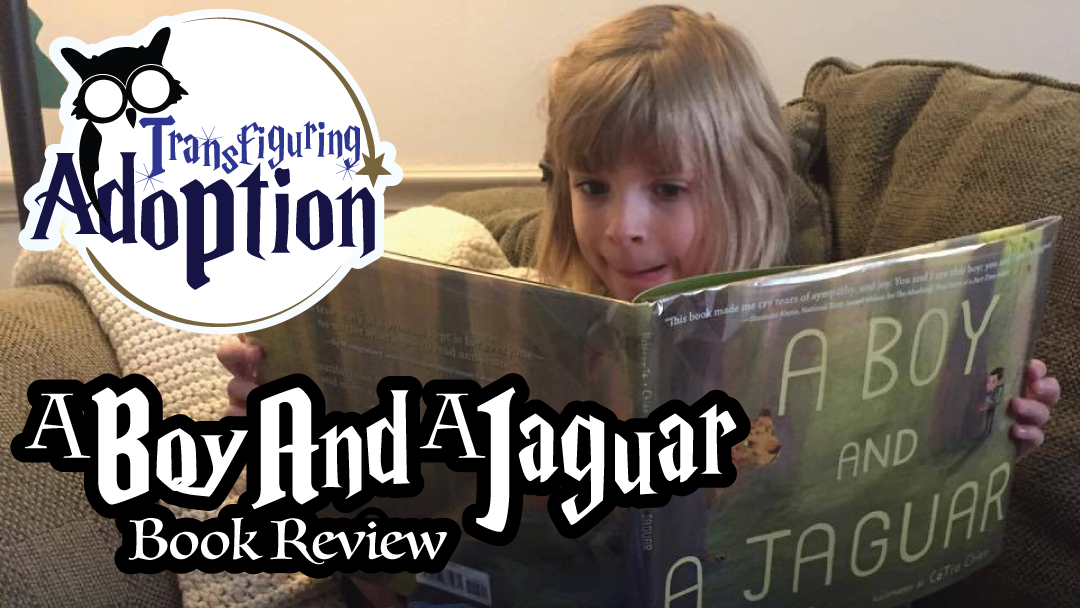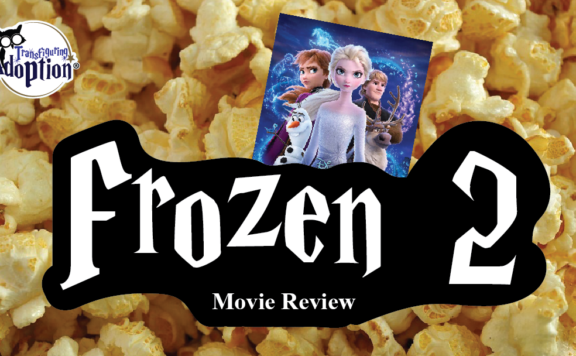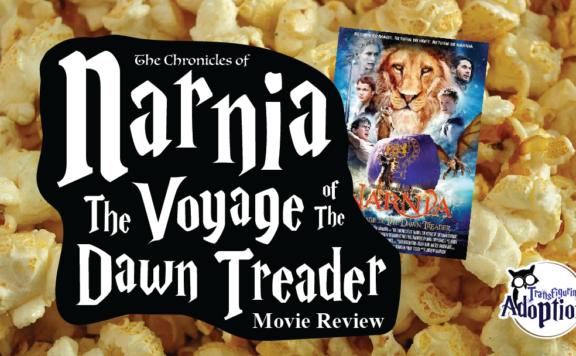Grade:
Transfiguring Adoption awarded this movie 4 Hoots out of 5 based on how useful it will be for a foster/adoptive family. [Learn more about our Hoot grading system here]
Movie Info:
- Rating: G
- Genre: Animation, Comedy, Kids & Family
- Runtime: 103 minutes
- Studio: Walt Disney Pictures
From the Cover of Toy Story 3 (2010) by Walt Disney Pictures:
Toy Story 3 welcomes Woody, Buzz and the whole gang back to the big screen as Andy prepares to depart for college and his loyal toys find themselves in… daycare! These untamed tots with their sticky little fingers do not play nice, so it’s all for one and one for all as plans for the great escape get underway. A few new faces-some plastic, some plush-join the adventure, including iconic swinging bachelor and Barbie’s counterpart Ken, a thespian hedgehog named Mr. Pricklepants and a pink, strawberry-scented teddy bear called Lots-o’-Huggin’ Bear.
Transfiguring Adoption’s Overview:
In this installment of the Toy Story franchise the audience returns to Andy’s room to discover a significant amount of time has passed since Toy Story 2. Andy is now a young adult packing for college and trying to decide what to do with the toys that remain before he leaves… which leaves the toys in quite a predicament. Live in the attic to hope one day Andy has kids and retrieves them? Be donated to a daycare? Or, worst of all, be thrown away with the garbage?
The target audience appears to be children ages 4 and up. It also appears this movie would be best for foster and adoptive families as the movie is a fun film to watch together with some themes that relate to a child’s experience with foster care without showing a child going through trauma. There is a large emphasis on loss, transitions, and grief that children may relate to and be able to use as a medium to discuss difficult feelings concerning those subjects. This film is an excellent movie for a family to bond over movie night with some discussion for most ages for this reason.
** Spoilers Could Be Ahead **
How Is This Relevant To Adoption & Foster Care?
Right from the get go caregivers can quickly see how children may relate to Jessie’s worry of being abandoned, Woody’s struggle with loyalty to Andy, and the rest of the toys trying desperately to cope with the inevitable transition. Of course, some of these subjects may be hard for children to discuss but for some children talking about how Woody deals with transitions may be easier than talking about themselves. This movie can provide a wonderful opportunity for caregivers to bond with their children, talk about hard subjects, and reinforce their love and care over and over as they discuss the film.
Discussion Points:
- Abandonment and Grief
No matter the reason a child enters the child welfare system, often the child will at some point struggle with feelings of abandonment. One teen I worked with once struggled with an immense amount of behaviors that seemed to always get her in trouble. She told me, “I’m just afraid if I don’t make sure someone will forget I’m here. And I can’t have that ever again.” Often children, as a part of the grief process, blame themselves for entering the child welfare system and fill in missing pieces of information with their imaginations. Others truly have been abandoned by parents, grandparents, aunts, uncles, and even previous foster placements. Caregivers love children and don’t want to see children suffer, so it’s easy for a caregiver to try to cheer up the child or distract them from their pain. However, when this happens it only delays the inevitable and the caregiver has violated that child’s right to grieve. We must remember: They didn’t sign up for this. Caregivers are in the best position to make sure that when a child does grieve they never have to do it alone. - Transitions
Even when a transition is a positive one, children who have endured trauma may react to change as a threat to their survival. And who can blame them? With multiple placement changes, caregiver changes, school changes, friend changes, and more it is completely valid that transitioning to the next school year or into an adoption may shake a child to their core. Children who have endured trauma often have an overactive stress activation system, meaning they are on red alert for survival at all times and this will be very difficult to reassure and change. For this reason caregivers should strive to be trauma-informed so that they can see past the meltdown and that a child is responding to a sense of feeling unsafe and desperately needs to be reassured and comforted. - Loyalty Conflicts
This is a very familiar issue across the board within foster and adoptive families. A child has their biological family, and though they may be abused and neglected, that was their first relationship that taught them how to love and be loved. They also have a caregiver (foster or adoptive parents often) who cares for them every day and gives them everything they could need. A child who has endured trauma may struggle to integrate all the support and love (and sometimes even be influenced by how the biological family or caregivers speak of one another) and feel they must “pick” a side. For this reason it is very important that caregivers be mindful of how they speak of the child’s biological family, whether they are present in the child’s life or not. We must remember that the biological family holds a large portion of your child’s identity, and when we fail to acknowledge them and what they contribute to the child we are failing to recognize a part of our child’s identity.
Cautionary Points:
- Cartoon action sequences
These include a train robbery/rescue, sneaking out of a jail-like situation, stunts that involve jumping from great heights, outrunning a chipper and furnace, and violent interactions with hands/feet (i.e. – fist fights) and with weapons (i.e. – nunchucks, lasso). Caregivers should be prepared if their child has a tendency to mimic such actions at home. - Inappropriate Punishments
Characters are shown being tied up and blind folded as well as being placed in shelving baskets to represent imprisonment for punishment for misbehavior. A character is also put in seclusion overnight in a sandbox for punishment for misbehavior. This can be harmful for children who have endured traumas related to seclusion. - A lot of sequences concerning abandonment
Jessie experiences a panic attack about possibly being thrown away, toys are accidentally thrown away, toys believe Andy is flippant about their fate and does not care, Lotso Bear pulls toys into the trash with him, Lotso is verbally abusive to other toys in response to grief from abandonment, Woody lashes out at other toys verbally over being given away and feeling abandoned, Lotso, Chuckles and Big Baby being left at a rest stop, etc.). There are also sequences with toys getting their hopes up concerning reunification (i.e. – toys believing they can go back to Andy, Lotso, Chuckles and Big Baby returning to Daisy to find she got a new Lotso Hugs doll, toys going to Bonnie’s home, etc.). Children may be triggered by similar feelings due to traumas related to abandonment and feeling “thrown away”. - Runaway behaviors
The Toy Soldiers are shown escaping before they potentially could have been thrown away by Andy. They reappear at Bonnie’s house during end credits with no ramifications for running away and being in a potentially dangerous situation on the outside. Caregivers should be aware in cases where children struggle with runaway behaviors in response to fear. - Harmful and abusive systems in place in Sunnyside Daycare
The daycare is run with a mob-like air and Lotso keeps new toys under lock and guard to ensure he and his cronies remain in the coveted Butterfly room. This leaves toys he does not favor in the toddler room where they are openly abused and harmed by toddlers in play. Lotso created this system intentionally to harm other toys and maintain control over the daycare and perpetuate the abuses over and over. This may be triggering due to past traumas in the family home, in previous foster placements, or negative experiences with congregant care. - Lotso is a horribly manipulative and abusive character
While yes, we can identify he has endured trauma Lotso is an example of what happens then trauma is not transformed. Lotso lies, cheats, steals, and controls others with violence and with very verbally abusive statements to others. Lotso cycles between overly positive rewards and very hard punishments which mimic cycles seen in domestic violence and traumatic relationships of similar natures. Caregivers should be prepared to monitor a child who has had such experiences for trauma reactivity. - The toys are shown being put in a trash bag
This can be harmful specifically to children from foster care due to the use of trash bags for packing up belongings before moving placements last minute (though agencies are certainly trying not to do this anymore) and the connection may persist for a child. - Toys are in mortal peril multiple times.
They are crushed by objects (and in Buzz’s case believed to be dead), crushed in a dump truck, and almost sent through an incinerator. - Buzz is shown to be “reset”
He is basically brainwashed to perpetuate abuses and control on behalf of Lotso’s gang. He requires being restrained to be reset (putting him in Spanish mode) and then is only righted with head trauma from having a TV dropped on him. - Bathroom humor
There are a few subtle bits with toilet humor concerning “Linkin Logs” in the sandbox. - Disturbing character
The monkey acting as Lotso’s surveillance I personally found to be very creepy in appearance and demeanor. - Undressing Behavior
Ken is tied up in his underwear when detained by Barbie. This does make sense in context of the scene (as Barbie is ripping up his favorite clothing as motivation to get Ken to spill information) but caregivers should be aware if your child has a history of trauma involving being tied up or undressed. - Lots of transitions and grief are shown
Andy and his mother have a moment to say goodbye, the toys have several moments where they are processing grief related to abandonment, there is a VERY emotional goodbye between Andy and the toys at the end, and toys respond to grief from losing toys before the events of the film.
Discussion Guide:
- Why do all the toys become afraid when talking about whether Andy will keep them in the attic or throw them away? How do they all show they are afraid?
Caregiver Note: This question will bring to awareness the emotions that motivate the behavior of panic. Children who have been through trauma and have been neglected often lack the social and emotional skills to connect feelings to behavior. This discussion will help a child use a less personal example to illustrate how the panic doesn’t just “happen” but starts from reactions in the brain we cannot see. Some examples of why the toys are afraid can be that other toys have been thrown/given away before, Andy’s tone indicates lack of care, past history of being abandoned (in Jessie’s case by previous child Emily), being put in trash bags instead of boxes, etc. The way we see toys express these emotions vary with panicking, jumping to conclusions, anger, and sadness. - Was there a time where you were afraid of being left behind? How did your body react to show you felt afraid inside?
Caregiver Note: This question will give your child the opportunity to practice connecting feelings to behaviors. Deep down when people are afraid they may react with as many outward emotions and behaviors, all of them valid. Anger, depression, bargaining, and denial are all very common, and essential, responses to immense grief and need to be understood and honored to eventually reach acceptance. Work with your child to practice using words in connection to the emotions and behaviors. This will help with emotional intelligence as well as give some language processing practice that traumatized brains often lack from neglect. - What can I do to let you know that you will not be left behind or forgotten? How can I help when feelings from before come back to help you feel loved?
Caregiver Note: Over the course of the films we see that Jessie grows and thrives in a home with a loving child to treasure her. However, the moment that sense of felt safety is violated she retreats back to the panic she felt well over a decade (or more) ago. Caregivers must remember that what we view as safe and what a child views as safe while they are in a state of stress may be totally different! Take this opportunity to find ways to help your child feel safe in your home and reassure they are safe as needed. Take note as well to events they have connected to behaviors as meaning they are afraid as this will also help you to decipher your child’s trauma behavior they are using for communication in crisis. - ACTIVITY: Mini Chunk Faces
Caregiver Note: For this activity you will help your child to create a mechanism like Chunk’s facial emotions from the movie. If you recall, Chunk is a spiky, rocky fellow who can change his emotion with a roller mechanism. For this activity you will need large empty thread spools, tape, cardstock paper, construction paper, markers, scissors, and thread. Take the spool and help your child draw different faces such as angry, sad, happy, and worried. Then, take your cardstock paper, scissors, and tape to cut out a box that will fit the length of the spool, leaving a window on the front for the “face” to show. Poke Holes in the side for your thread and thread it through the center of the spool and holes, tying and securing the thread with tape on the bottom. The thread will need to be tight enough to hold the face in place and have enough slack to allow the spool to rotate. You can reinforce with yarn if the spool is too large for thread. Then you can cut out some arms, legs, and spikes out of construction paper (using your imagination for however you’d like the limbs) and color your box and construction paper to decorate your Mini Chunk. This will be a great way to connect facial expressions to emotions and can even be used when words are difficult to convey feelings! - When the toys made it to Sunnyside they had a lot of expectations about what daycare would be like. How did Sunnyside compare to what they expected on the first day? How about after they found out about the Butterfly Room? How about after Woody and the gang moved to Bonnie’s?
Caregiver Note: For children in foster care, change feels like an assault on their brains. Due to overactive stress systems in their bodies they are frequently bathed in cortisol and adrenaline so any measure of the two can inhibit intense fear. This means they may imagine all sorts of scenarios that either comfort or soothe them or may amp them up with more fear and terror. For the toys in this situation they seemed to be more optimistic about their prospects as new toys while on route, but before that going to daycare seemed very scary and full of unknown possibilities. Once they arrived, of course, they discovered a mix of good and bad experiences. Ultimately the group did split up with Barbie staying with Ken at Sunnyside and the others going to Bonnie and they were all able to settle into new life that gave them exactly what they needed. With this we can talk to children about being prepared for new, exciting situations and remembering that though things may go bad they can also turn out better than we could have hoped. - How were Barbie and Ken able to turn Sunnyside around and make it a better home for toys in transition? How can I give the same feeling to you?
Caregiver Note: With this question we address that feeling of felt safety again. For Ken and Barbie they had a friendly meet and greet, a rotation of “hard chores” (i.e. – playing with rough toddlers) with easier chores (i.e. – the Butterfly Room), and giving support when doing hard things. This is a complete turnaround from the iron fist Losto used in the past. Listen to your child and take note of ways they may need support. - Even though Woody hasn’t been played with by Andy for such a long time he still wants to stay with Andy. Why does Woody keep believing that he and the toys won’t be given or thrown away?
Caregiver Note: One thing parents usually know after raising siblings is that every child is completely different. For children with trauma, this is amplified depending on how much resiliency a child has developed. Resiliency is built by factors such as a parent’s understanding of child development, a child’s social and emotional competence, a parent’s resilience as well as when trauma occurred. In Woody’s case, he has been with Andy’s loving care for much longer than the other toys and has seen through the years that though Andy’s need for him may change, that Andy will still have love for him. Because of these experiences with Andy being overall positive and seeing time and time again that Andy’s love is not conditional, Woody has an easier time reminding himself of these experiences and acting with them in mind. - Buzz, Jessie, and the rest of the toys are quick to believe that Andy will throw them away even though he has kept them for so long. Woody even tells them he saw the mix up with Andy’s mom happen, but they were still determined that they were being left behind and should seek another home.
Caregiver Note: Not only have these toys not had as much time as Woody with Andy, some of the toys have had painful separations from Andy or previous children. In Jessie’s case, she has experienced the pain of a child outgrowing her and is terrified of returning to a dark box again. Buzz, though only having temporary separations in the past, is more inclined to also believe that this is the inevitable outcome for toys that are outgrown and tries to move forward quickly to avoid pain. The others (Mr. Potato Head, Hamm, Rex, and Slinky), though in the home longer than Jessie or Buzz, have throughout the films already seemed to change sides or loyalties depending on what appears to be in their best interest of survival. This is another way where we can see how so many factors may affect how a child perceives conflict or change regardless of the level of care or amount of time within a home. - At the end Woody learned he did not need to choose Andy over another child and could share his love with both Andy and Bonnie. In the same way, I want you to know that you don’t have to choose our love or your biological family’s love. You can have as much of both as there can be. How can I help you feel like you don’t have to pick sides with me and your biological family?
Caregiver Note: Children who live in temporary or permanent care away from the biological family will feel like they are in a tug-of-war at times. Do I love my family that birthed me or the family that found me? Sometimes inadvertently (or obviously) adults can also feed into this internal struggle and this can lead to conflict within the caregiver’s home. Remember, whatever you say or respond with about the biological family you are ultimately saying about a part of your child’s identity. Really listen to your child and take note of what they say as well as how you speak of and react to talking about the biological family. - Activity: You Made It On the Wall!
Caregiver Note: Help your child draw a picture of their families. Help them draw siblings, foster siblings, biological parents, your family, and anyone else who deserves to make it on The Wall as someone who loves the child and cares for them. Then, take those pictures and arrange them in a place the child can see regularly. For those who may not be able to hang up pictures like this on the wall, paste or tape them onto a poster board so that the poster can be propped up and seen in their room. Reassure your child by allowing them to talk about their family during the activity, remembering that they are a part of their identity.
